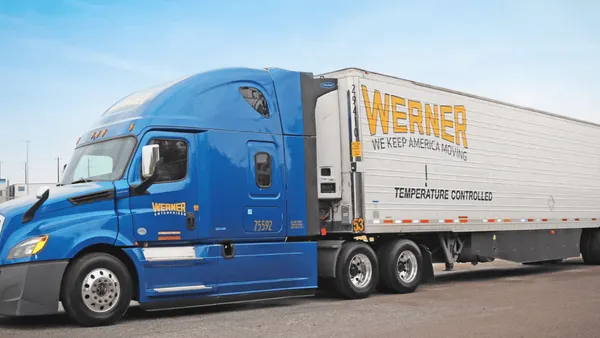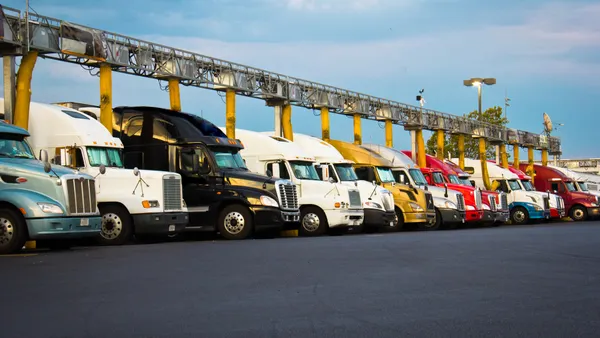Dive Brief:
- Commercial automotive insurers lost $4 billion in 2019, the worst loss in 10 years, according to a new report by AM Best. The credit-rating agency noted insurers have faced a years-long trend of mounting losses insuring commercial vehicles, from fleets with Class 8 trucks to passenger-car fleets. Carriers and their insurers have been plagued by claims and liabilities in the last few years, with some fleets seeing profit margins shrink and others going out of business because they could not pay insurance costs.
- The industry's loss comes even as insurers place double-digit, year-over-year increases in premiums upon carriers and fleets, hoping to make up the losses. Growth in the insurance industry's losses and loss-adjustment expenses (the cost of investigating and settling claims) are to blame, AM Best officials said.
- According to AM Best's report, two insurance-related trends in courtrooms are "wreaking havoc" on the profitability of trucking companies. One trend is "nuclear verdicts" — large jury awards of $10 million or more, which the reports says are inflating. Driving these larger awards is a speculative action known as litigation financing, AM Best reported. Litigation financing is when "a third party finances an attorney's cases ... resulting in bringing a growing number of cases to trial, leading to higher litigation costs." The dual trends are vexing the insurers, who have to pay the claims, and the transport industry, which has to pay higher premiums.
Dive Insight:
Insurance costs and large jury awards have been dogging carriers for years, and part of the blame falls on the trial attorneys, according to the American Trucking Associations (ATA). The ATA has announced it will push for tort reform in all the states and Congress. But the AM Best report indicates there is plenty of blame to go around.
The report says commercial drivers sometimes commit distracted driving, and some fleets are taking "inadequate safety precautions." Commercial fleets have also been slow to adapt to current technology and innovations used by auto drivers, the report states.
"These challenges have helped prevent a notable improvement in [insurer] profitability, even before COVID-19 upended every segment of the insurance industry," AM Best officials reported.
The ATA's research arm, the American Transportation Research Institute (ATRI), produced a June study about the effects of large jury awards, litigation and nuclear verdicts on the trucking industry. Dan Murray, ATRI SVP, said structural change is needed to reduce costs for carriers and the insurance industry.
One problem is the widening gap between negligence and liability. Murray told Transport Dive that means a carrier may have some or a small amount of negligence in an accident but could be sued for 100% of the damages. Too many states allow that, Murray said.
That gap has led to annual double-digit increases, of between 10% and 15%, in premiums for safe carriers. Carriers with a few more accidents or problems are seeing even larger premium increases, which are disconnected from any proportional jump in carrier-related accidents and fatalities, Murray said. Ultimately, the cost increases will get passed on to the consumers, Murray said. Or fleets will go out of business. Such examples are not rare. The Wall Street Journal reported on Jan. 13 that Fleetwood Transportation Services, a Texas carrier with about 100 company trucks, shut down on New Year’s Eve 2019 after it could no longer find affordable insurance.
Ronnie King, Fleetwood CFO, told the Journal "insurance was the only factor" in its shutdown.
The rewards that can be accumulated in a successful lawsuit have led some third parties to finance the lawsuits against carriers, according to AM Best and ATRI. AM Best found when litigation-financed cases go to court, "many plaintiffs assert that it is not just the driver who causes the accident at fault, but also the trucking company, because the driver was overworked or undertrained, or the company violated safety regulations."
Sam Hanig, senior industry analyst for AM Best, said during a webinar held by his company that he expects the insurance costs to produce more safety and documenting innovations, such as guard-rails along the sides of trucks and wider use of digital cameras inside and on the outside of trucks.
As for jury awards, Hanig said there could be a wider cultural problem for corporate carriers.
"The composition of juries is changing," said Hanig. "What we are seeing, and what companies report to us, is that more millennials are becoming part of juries, and fewer baby boomers ... as well as just the attitudes and mindsets of the people who are part of juries. There might be more anti-corporate mindsets, and this leads to higher results."
Hanig said the growing awards are part of a larger problem. Juries are increasingly finding commercial carriers liable in the types of cases that normally would have carried no jury award a decade or two ago, Hanig told a panel.











